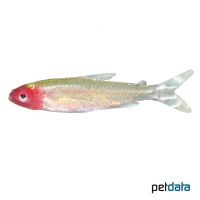False Rummynose Tetra (Petitella georgiae)
| False Rummynose Tetra Petitella georgiae | |
|---|---|
| Name | False Rummynose Tetra |
| Name Lat. | Petitella georgiae |
| Family | Characins |
| Family lat. | Characidae |
| Order | Characins |
| Order lat. | Characiformes |
| Origin | Peru, Brazil |
| Habitat | Streams |
| Diet | Omnivore |
| pH | 5.5-7.5 |
| Behavior | Peaceful |
| Keeping | Group |
| Care Level | Moderate |
| Reproduction | Egg scatterer |
| Breeding | Difficult |
| Life Span | 4-5 years |
| Protection | No |
| Metric Units | |
| Size | 5 cm |
| Temperature | 22-26 °C |
| Hardness | 1-15 °dH |
| Aquarium | 100 l |
| US Units | |
| Size | 2" |
| Temperature | 72-79 °F |
| Hardness | 18-267 ppm |
| Aquarium | 25 gal |
Distribution and habitat
Georgis redmouth tetras are native to the watersheds of the Rio Purus (Peru, Brazil) and the Rio Negro and Rio Madeira (Brazil). They live in small, stagnant rivers and tributaries with clear water and dense riparian vegetation.
Maintenance
The aquarium should have a varied, partly dense planting, with shelters and hiding places (roots) and provide sufficient swimming space. A dark substrate covered with some foliage (e.g. sea almond leaves), shaded light (floating plants) and a weak current is ideal.
No ammonia, ammonium and nitrite should be detectable, the nitrate value should not exceed 100 mg/l. To ensure the water quality and oxygen content, a filter and heater adapted to the aquarium size is required, as well as lighting for the species-appropriate day-night rhythm of the animals.
Diet
The food supply consists of live food, such as daphnia, cyclops, artemia and mosquito larvae, which is also eaten in frozen form, supplemented with frozen food mixtures. Dry food, such as flake and granulated food is also well accepted. In addition, they occasionally require vegetable food, such as crushed peas, mashed leafy and wild vegetables, or dry food with high vegetable content (spirulina, kelp).
A regular and varied diet promotes health and increases resistance. Only feed as much as is eaten immediately (in a maximum of 10 minutes).
Behaviour and compatibility
They are swimming, peaceful schooling fish and well suited for a community tank with other, not too large and peaceful fish. At least 5, but preferably more Georgis Redmouth Tetras should be kept together.
Basically, only mutually compatible fish species with similar demands on water conditions and water temperature may be socialized.
Sex dimorphism
The sexes are difficult to distinguish. Males have stronger contrasts in the stripe coloration of the caudal fin. Females appear slightly rounder.
Reproduction and breeding
In soft, slightly acidic peat water they usually spawn between fine-feathered plants (free spawners). The larvae hatch after 24-36 hours and swim freely after 3-4 days.
Juveniles must be fed several times a day with special rearing food (dust food). In community tanks breeding is hardly possible, because the spawn is easy prey.
Important
The water temperature should not exceed 26 °C in the long term
Feeding with vegetable food reduces the risk that the fish will eat the tender shoots of aquatic plants.
Georgis redmouth tetras are easily confused with Hemigrammus rhodostomus (Ahls redmouth tetra) and Hemigrammus bleheri (redhead tetra)
The well-being of the fish should be checked regularly. Temperature should be checked daily, pH, hardness and nitrate levels should be checked at least every 14 days. Regular partial water changes are recommended, even when contaminant levels have not yet reached the upper limit. Sudden changes in water quality should be avoided. Newly introduced fish must be accustomed slowly to the water in the aquarium.
Further literature can be found in your pet store.
References
Text: petdata; Image: petdata
Source: BMELV (1998): Tierschutzgutachten - Haltung von Zierfischen (Süßwasser); RIEHL & BAENSCH (2006): Aquarien Atlas Bd. 1, Mergus Verlag; ENGELMANN (2005): Zootierhaltung - Tiere in menschlicher Obhut: Fische, Verlag Harri Deutsch
- Gemäß § 21 Abs. 5 Tierschutzgesetz idgF
